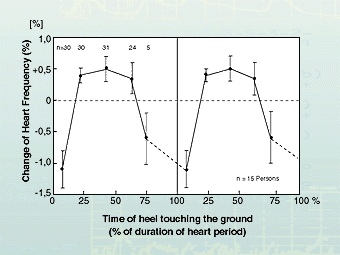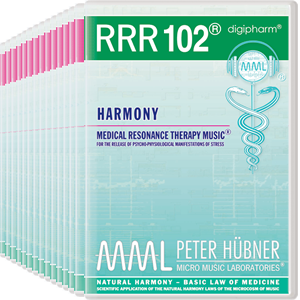| サイエンティフィック・ミュージック・メディスン | |
| Home • Site Map • Research • Reports • 国際的専門家 • Music Preparations • Fundamentals • News • ペーター・ヒューブナー • Store • Contact | |

Prof. Dr. med. Gunther Hildebrandt • Chronobiological Aspects of Music Physiology
Experimental studies with a systematic variation of the phase relations between heart rhythm and pace rhythm have shown that the heart rate clearly decreases as an expression of increased economy, when the phase co-action of both rhythms is reconciled with the one which is also chosen for spontaneous walking and running (illustration 18).
The energy saving effects of the phase linking therefore also apply to the relations between vegetative-autonomic and motor rhythms.
The energy saving effects of the phase linking therefore also apply to the relations between vegetative-autonomic and motor rhythms.

Illustration 18
The influence of the phase relationship between walk rhythm and heart rhythm (time of putting one’s heel down within the heart period measured from the R-Point of the electrocardiogram) on the heart rate when walking (deviation from the average frequency) in 15 test subjects. The heartbeat of these subjects was made audible with a systematic delay. The decrease of the heart rate is the largest when the heel comes down in the R-Point area. For a better overall view, the results are applied twice, one behind the other.
(According to dates by DIETRICH 1982)
|
€г—Г‹¤–ВѓZѓ‰ѓsЃ[ѓ~ѓ…Ѓ[ѓWѓbѓN®
Medical Music Preparations on CD |
| Listening Program: Harmony 
|
|
If you like to look at the complete program, |
With kind permission of AAR EDITION INTERNATIONAL
© 1998- SCIENTIFIC MUSIC MEDICINE | Contact
Subject to change in the interests of scientific advancement.
© 1998- SCIENTIFIC MUSIC MEDICINE | Contact
Subject to change in the interests of scientific advancement.